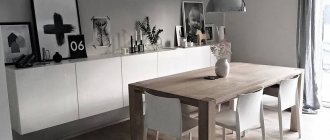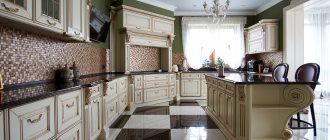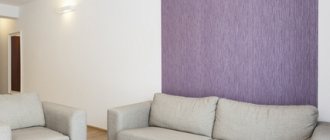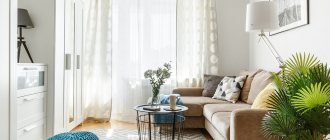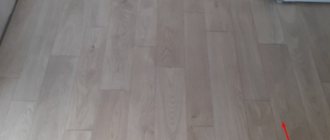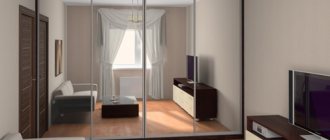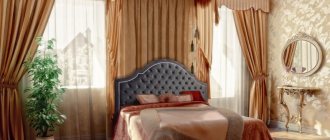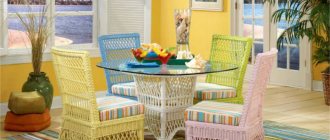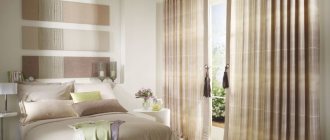It is important not to make a mistake when choosing the type of wood for the top layer of the parquet board. Unlike cheaper materials, where the main layer performs an aesthetic function, with this coating it also affects performance.
Photo: idealhome.co
The hardest and therefore most durable product is oak board. It does not dry out and tolerates changes in humidity well. This product should be used in areas with high traffic and intensive use.
Calculate the exact cost of repairs using an online calculator
and receive a free detailed estimate for repairs
Calculate
But if the designer in you has awakened and you want something unusual, you can use softer materials such as walnut or cherry, which have a variety of intricate textures and pleasant colors. A parquet board made from a combination of different types of wood will create a non-standard, expressive atmosphere in your apartment.
1/2
2/2
Our new products
Parquet boards are universal; they combine aesthetics, comfort and practicality. But it’s better to see once than to hear (in our case, read). We will try to illustrate the use of this material.
Wide plank floor
Such parquet boards look noble in spacious rooms. It is perfectly complemented by wooden furniture and accessories made from natural materials. And the natural color emphasizes the richness of the interior.
Photo: izig.net
Care Tips
Parquet boards are considered a very difficult material to maintain. For the first time after laying the floor, it is not recommended to jump, run or subject it to other serious loads. If there is a need to rearrange the furniture, then the parquet board is covered with thick cardboard. The floor should be cleaned regularly with a vacuum cleaner using special soft attachments. If there are “clawed” pets in the house, then their “nails” will have to be systematically trimmed to prevent the possibility of scratching the top layer. Wet cleaning should only be done with a soft, slightly dampened cloth or sponge. Under no circumstances should you use abrasive compounds that contain small solid particles. Such substances will inevitably scratch the top layer of the parquet board. You cannot walk on the floor in heels and bring sand onto it. The effect of the latter is akin to abrasive compounds. To wash floors, it is recommended to use special products that are designed specifically for caring for parquet boards. Mobile furniture should be purchased on special rubberized wheels. Alternatively, you can buy special felt pads that are attached from below.
Large parquet pattern
Living rooms, halls, halls require appropriate flooring. They will undoubtedly be decorated with a large floral or geometric pattern created from parquet boards of various shades and textures. The size of the ornament (whether it will occupy the entire surface of the floor or only part of it) depends on the area of the room and, of course, your preferences.
Photo: mit24h.com
Art
In our opinion, it is artistic parquet that stands out most advantageously among other natural coverings. It is made from rare hardwood. When laying a parquet board, a real picture is formed that can add a sophisticated touch to any interior.
There are two main types of artistic parquet: picturesque and geometric . The first type of coating forms an unusual picture with many branches. In the case of a geometric pattern, the pattern is duplicated throughout the base of the floor covering. Geometric parquet is somewhat reminiscent of classic mosaic.
The beauty and chic of artistic parquet
Most often, artistic parquet is used to zone a room or, conversely, to combine floor coverings from different rooms into one. There are such varieties of artistic parquet boards and types of elements as:
- Mosaic . This is a repeating pattern, which is most often complemented by rosettes.
- Sockets . Such a complex pattern is laid out in the center of the room.
- Curbs . Designed in the form of geometric shapes or complex patterns (flowers, butterflies).
Incredibly beautiful drawings will not leave anyone indifferent
Parquet door
In rooms where there are few colors and textures and you don’t want to add anything extra to maintain the style, designers suggest making different interior details from the same material. For example, you can install a door made from the same parquet board as the floor. The room will look holistic and harmonious.
Photo: garofoli.com
Materials
The quality of parquet, its durability, resistance to heat and water, as well as color depend on the material from which it is made.
The front side of the parquet is always made of hard or soft wood. To give natural wood greater hardness and heat resistance, it is subjected to heat treatment. Thermowood floors (thermo-ash, thermo-oak, etc.) have one drawback: they fade over time in the light. It is quite often used to make the top layer of parquet boards.
The most popular types of wood in Russia for making parquet and solid wood panels are oak and ash. This is a fairly frost-resistant species, the floors of which look very noble and elegant due to the pronounced wood texture. Oak has a light beige tint, stained oak is darker, ash is yellowish, like honey. Parquet made of birch and natural larch has a light shade. Karelian birch is harder and more wear-resistant than common birch, beech is easy to process, durable and wear-resistant. Beech parquet has a honey tint.
Maple parquet is a light, almost white floor. But over time, maple acquires a yellowish, honey-like hue.
Bamboo has a number of advantages over other types of wood, as it is quite hard and moisture-resistant, has high wear resistance and does not require special care.
Mahogany is a dark wood. Flooring has a high price, but is in great demand due to its quality and noble appearance.
Walnut parquet has a warm brown color. European walnut, as well as American walnut, are very hard woods, so they are in great demand. This is an expensive material, it is resistant to moisture and is difficult to damage mechanically.
Popular types of wood for making parquet are also cherry, hornbeam, chestnut, wenge, lapacho, mahogany and others.
If for the manufacture of parquet, in addition to piece parquet, only one type of wood is used, then for mosaics, artistic parquet, modular parquet and parquet boards, several types of wood are needed simultaneously, matching in heat, humidity and wear resistance.
For the production of parquet boards, only high-quality wood species are used for the top layer. Painted in several layers. The bottom layer is covered with veneer.
Modern parquet is made using not only high-quality wood, but also inexpensive natural materials (for example, leather parquet) and artificial ones. Faux vinyl flooring, which imitates the appearance of natural flooring, has several important advantages. It consists of almost 80% PVC and therefore has excellent moisture resistance, wear resistance and elasticity, and is not affected by chemicals and insects.
An alternative to traditional parquet is cork parquet. The bark of the cork tree is used to make it. As a rule, such flooring has several layers. The first layer is cork support, then wood fiber, then cork board. Decorative varnished wood veneer is laid on top of the cork layer, which gives the cork parquet a more elegant look.
The advantage of cork flooring is good shock absorption (which is especially important for people with musculoskeletal problems), thermal and sound insulation, respect for the environment and low price. The use of artificial materials for the flooring of the room is also justified. Plastic (WPC) is often used to make garden parquet, as it is less susceptible to moisture, is stable and has excellent heat resistance.
Two-color herringbone
But in the modern interior of a living room, herringbone parquet looks somewhat banal. To diversify the appearance of the room, use parquet boards in two colors. The photo below shows an example of how this can be done.
Photo: mckenzieandwillis.co.nz
Parquet in various interior styles
If you are an adherent of a certain style, then you will definitely be interested in the question of a well-chosen floor base that would fit into the overall design. Let's focus on the most popular trends today - classical, Scandinavian, ethno, art deco and high-tech.
- To make Art Deco more interesting, use bright wood that will stand out against the background of objects and textiles. The main note of this direction is individuality.
- For cold high-tech, light logs without a pattern or with slight natural stand-out wood fibers are perfect. It is better to choose a matte texture - this will partially eliminate coldness and angularity.
- An exotic type of wood will fit perfectly into the ethnic direction. You can choose a more trivial one, but let it be dull. This will give the interior completeness and create an atmosphere of country comfort.
- Scandinavian style involves the use of exclusively light natural shades, so gray and muted sand tones, barely distinguishable from white, are just right. An artistic design is inappropriate here, but stand-out wood fibers will add even more comfort.
- In the classic direction, oak or alder in dark, rich shades looks great. Opt for a modular option, piece or artistic - this will add a touch of royal nobility.
You may be interested in: Interior design styles: from traditional to the most unusual. Consider more than 90 interior styles
As for other areas, consider furniture and general lighting first when choosing a board.
Colored Christmas tree
You can go even further and paint some details of a regular parquet herringbone in colors unusual for wood. The main thing is not to overdo it with the number of painted elements and the variety of the palette, so that the floor does not look too colorful. It looks original and fun.
Photo: welcome-hayakawa.com
Parquet color
The color of the flooring should match the design. The good news is that they are all natural. And even yellow, pink and red will go well together.
Dark tones look rich and impressive, however, you should be extremely careful with them. Small debris and dust will be visible on a dark floor, so be prepared for daily wet cleaning. But chips, small scratches and cracks can be easily hidden with special waxes if the texture is matte. Glossy, on the other hand, reveals all visible imperfections at once.
Another nuance is the visual reduction in the area of space. A black floor visually narrows the space, so it is not recommended to lay it on already small areas. Or try alternating dark elements with lighter ones.
Dark lacquered parquet reflects light well, so it is often used in small rooms with a sufficient number of light sources.
A completely different matter is light shades. They are able to expand and enliven even a tiny, faceless space, especially if the surface is varnished. It will reflect the sun's glare, creating the illusion of a water surface.
The main thing is to choose everything correctly in accordance with the lighting.
Cool tones, which are characteristic of ash, hornbeam and maple, will fit well where the sun's rays fall almost all the time. If there is little natural light, then choose warmer ones (alder, beech).
Also consider the brightness of the furniture. Both similar and contrasting logs look good. When creating contrast, do not overdo it: use no more than 3 primary colors.
If over time the shade no longer suits you, you can change it a little or refresh it with the help of a special oil, varnish or stain. But first, try the composition on an inconspicuous area.
Parquet board tiles
Old houses have a lot of wooden elements: doors, jambs, stairs, inserts on the walls; and wood floors are no exception. Small parquet tiles made in the form of squares consisting of several stripes look appropriate and harmonious in such an interior.
Photo: brownstoner.com
Parquet in the interior
Living room
Parquet flooring in the living room should match the style, colors and furniture.
Although natural tones are suitable for any room, for the living room it is better to focus on patterned elements. And the larger the room, the richer the pattern.
As for functionality, for the living room choose a material with maximum resistance to mechanical damage.
Kitchen
Despite the fact that most housewives prefer to see tiles, as they are more practical, parquet in the kitchen is also gaining popularity every day.
For the kitchen, choose wood that is highly resistant to moisture and temperature fluctuations. Teak, oak, hornbeam and wenge work well.
You may be interested in: Stylish boutique hotel Hotel Justus 4* in the old town of Riga
Ideally, the elements should be fastened with a locking connection. The presence of even a small amount of glue will make it impossible to replace individual parts of the floor if the need arises.
Many people prefer to varnish the joists in the kitchen, and they do it right. Additionally, protected wood will last longer, and the varnish layer can be renewed if necessary. The main thing is that you need to choose a high-quality composition.
Bedroom
The floor base of the bedroom should set the mood for relaxation and not be full of drawings. To prevent the interior from looking boring, let the parquet in the bedroom contain 2-3 halftones.
Consider the expected load. If there is a lot of heavy furniture in the room, then the material should be chosen more stable. But practice shows that even one double bed already gives a considerable load, so take this parameter into account first.
Children's
When choosing parquet for a nursery, do not forget that unpredictable situations can occur in this room. A child can accidentally spill water, drop a heavy object, or get it dirty. Accordingly, the main criteria are moisture resistance and surface texture.
Environmental friendliness also plays a big role. Give preference to logs that are minimally treated with various compounds, but as smooth as possible. And also make sure that they adjoin each other tightly enough.
As for color, you can give free rein to your imagination - children love everything bright and unusual.
Bathroom
Contrary to the popular belief that parquet flooring is completely inappropriate for a bathroom, experts say that with proper work and well-chosen materials, the floors will last for many years.
Opt for the latest development by scientists - merabou coating. The fibers in it are located so close to each other that they will not even allow steam to pass through. This is explained by the homeland of growth - the tropics, where air humidity constantly exceeds 80%.
Take care in advance to protect the seams: buy only special glue, carefully prepare the base before work. And be sure to fill the spaces near the walls with high-quality waterproof sealant.
Pattern of dark and light shades
If you want the floor in your apartment to look like a continuation of expensive inlaid furniture, then you need to turn to the services of designers who will not only develop a layout in the form of a picture, but also select the appropriate materials: for light colors - teak, olive, iroko, for dark tones - wenge and stained oak.
Photo: ivoiregion.net
Types of wood
Depending on the type of coating used, the degree of deformation from humidity and resistance to mechanical stress changes.
- Oak is durable and suitable for different spaces. Thanks to its clear structure, it fits perfectly into many spaces.
- Teak is resistant not only to moisture and stress, but also to insects and fungus. For this reason, it is a favorite tree for outdoor spaces.
- Hornbeam is one of the most expensive species. It is distinguished by its special beauty after polishing and increased strength, but at the same time it is difficult to process.
- Wenge wood has an antibacterial effect.
- Ash is good for rooms with high loads, it is resistant to moisture, but does not like temperature fluctuations.
- Bamboo is environmentally friendly and will last a long time. It has a strong herbaceous odor and does not tolerate scraping.
- Beech does not tolerate water and high temperatures, but is easy to process.
- Maple is resistant to almost everything. The disadvantage is that after a couple of years the tree begins to gradually darken.
You may be interested in: Minimalistic gray-beige interior in an apartment of 116 sq.m. in Stockholm
Installation
If there is no special preparation for installing wall parquet, then this is not a problem. Because laying it on a vertical surface is even much simpler than tiling the floor. After all, there is no need to adjust, putty, or even scrape. And these are the most labor-intensive operations that require professional tools.
Thanks to the bevels on the front part, you are not afraid of minor unevenness during installation. They will make them invisible. And the “tenon-to-groove” technology will greatly facilitate and speed up all the work.
The entire installation process boils down to the following:
- The sheathing is made from slats. If the wall parquet is positioned vertically, then the grating starts from the ceiling. When horizontal or diagonal laying is planned, the beginning is laid from any angle. The batten is placed against the wall in increments of 40 cm.
- It is necessary to select in advance the elements for joining with each other. This is necessary because each die or slab has its own texture and shade. Therefore, they are first laid out in the order in which they will be mounted.
- You can attach parquet to walls simply with nails or self-tapping screws. But it’s better to use clamps. Special fasteners are first inserted into the groove of the element, and only then nailed to the grille.
- The first row is placed from below using a building level.
- Going through corners, window and door openings, the excess on the element is trimmed. The leftovers can be used to start the next row.
Thanks to hidden fasteners, the surface is clean and tidy. The joints are sewn up with special platbands. And if defects are found in the form of cracks and chips, they are treated with putty and subsequent sanding.
Wall decoration with parquet blocks Source rdstroy.by
And a few words about care. It is carried out only with the help of specialized means.
Classification
Depending on the density of the wood from which the panel is made, high-density or low-density parquet is distinguished. The dark brown wood is often dense. Pink wood (cherry, pear, alder, etc.) has a lower density.
The grade is determined by the method of cutting the wood from which the parquet is made.
Consider the following varieties:
- “Select” is an expensive high-quality parquet made by radial sawing. There are no knots or sapwood left on the board, the wood has a uniform color, and only minor mineral deposits are possible.
- Radial is also a high quality variety with uniform color and no sapwood, but the percentage of mineral deposits on the surface is higher and can reach 60%.
- The next grade of high-quality cut is “Standard”, it is of high quality, has no knots and sapwood, a slight difference in shade is possible. This type of parquet is produced by mixed cutting.
“Natural” parquet also refers to a mixed variety of sawdust, with the characteristic presence of sapwood and knots in small quantities, as well as a natural difference in tone.
- Rustic parquet is of lower quality, but affordable. Produced by mixed cutting, it has not only knots and sapwood on the surface, but also small cracks, as well as different natural shades of wood on the surface.
